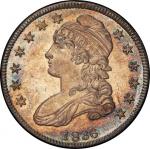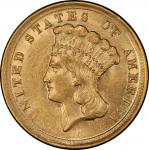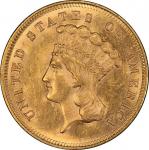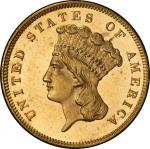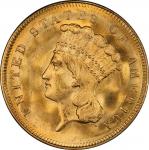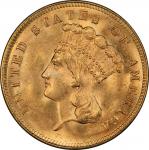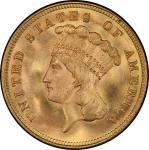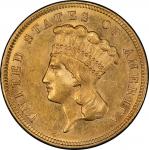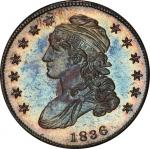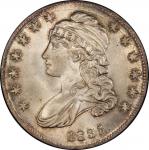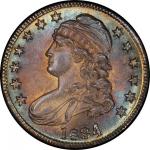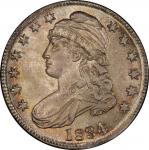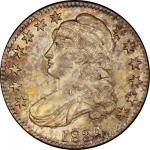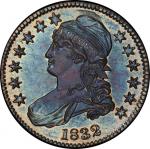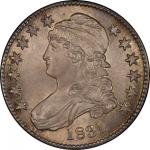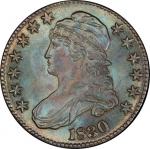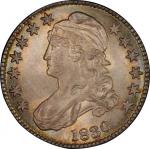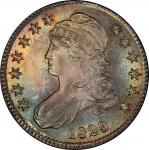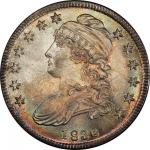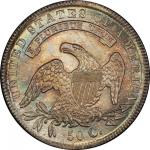“A report has been made to the House in favor of coining gold pieces of the value of one, two, and three dollars. This would be exceedingly convenient, and enable us to dispense entirely with the cumbrous silver dollars and five franc pieces, and would diminish the use of half dollars, which are also rather cumbrous.” — Philadelphia Public Ledger, April 11, 1836 Delicate toning of exceptional beauty graces both sides, arrayed with artistic splendor and rich with originality. The left obverse field is chiefly brilliant, lightly speckled with subtle toning, while the right side displays a pastel palette of rose, gold, sea green, and blue. The reverse is thoroughly toned in similar shades, with the southwest rim less toned and bright with silver brilliance. Magnificent luster brings life to these colors as this half dollar spins in hand. Even a discerning eye will find no significant defects, as the frosty surfaces show only the most minor evidence of handling. A wide arc die crack begins outside of star 1, crosses the bust tip and swinging around to the right side of the obverse above the date, where it nearly disappears. After crossing the inner point of star 1, it intersects another arc crack at star 2, which began at the denticles below and rounds to meet the tip of Liberty’s upper hair ribbon. The striking definition is superb on both sides, despite some softness among the denticles left of 6:00 on the reverse. For those out of reach of their dictionaries, cumbrous means bulky or cumbersome. Complaints about the size of half dollars and dollars were not new to 1836, nor were suggestions of the advisability of additional small gold denominations. As early as 1791, Alexander Hamilton called for “1 Gold piece, equal to a tenth part of the [eagle], and which shall be a unit or dollar.” In 1836, these concepts finally manifested in a struck coin, a trial or pattern that was never intended for circulation but merely to show how a gold dollar coin might look. Known today as Judd-67, the 1836 gold dollar was struck in March 1836 from dies by Christian Gobrecht. Don Taxay’s The U.S. Mint and Coinage recounts that Mint Director Robert Maskell Patterson submitted patterns to Treasury Secretary Levi Woodbury on March 14 and March 23. No 1836 gold dollars were ever struck for circulation, instead, the denomination would have to wait until 1849 for its debut in commerce. Still, the public spoiled for something easier than half dollars to carry around. “Is it less convenient to carry a small gold coin in the pocket, than to carry five half dollars, and is not the gold quite as safe, if not safer, than the silver?” asked the Gettysburg Compiler in June 1836. Silver dollar coinage began again in December 1836 after an intermission of nearly three decades, but still the newspapers complained. “A silver dollar is not so convenient as two halves, and weighs precisely as much,” wrote the editors of the Philadelphia Public Ledger in late December 1836. “Neither is a half dollar so convenient as two quarters, while it weighs precisely as much. It is therefore judicious to make silver coin as small as possible ... as silver in quarters can perform the office of silver in halves, and another office besides, we should be well pleased to see no other coins than quarters, dimes, and half dimes.” The topic died down for several years, and no new pattern gold dollars were struck until 1844 when the 1836-dated dies were employed again for an additional small mintage. Of course, one newspaper does not define public opinion, and it seems likely that most Americans had bigger issues in their lives than the half dollars in their pocket being too heavy. Once a part of the legendary Knoxville Collection type set, this coin may be the prettiest example of the Capped Bust design in the Pogue Collection. In 2002, Jay Parrino described it in the Knoxville Collection fixed price list as the “finest of its date ever to be certified.” Nearly 15 years later, it remains the finest example of the 1836 Lettered Edge seen by PCGS, a coin that approaches technical and aesthetic perfection. PCGS# 39948. NGC ID: 24G2.

